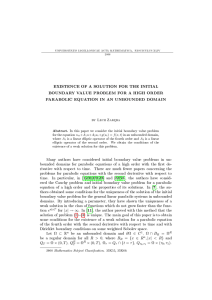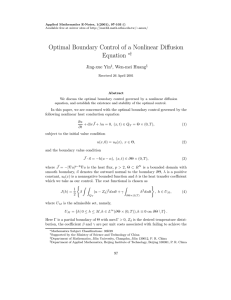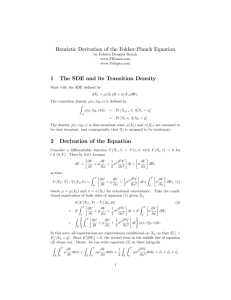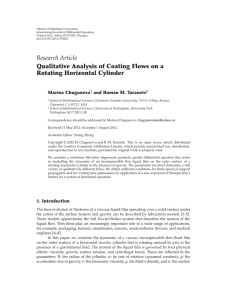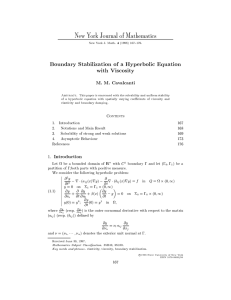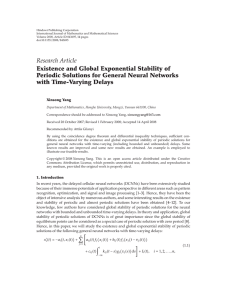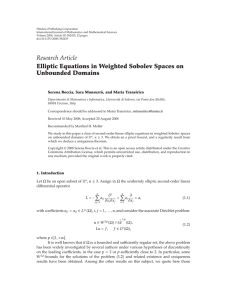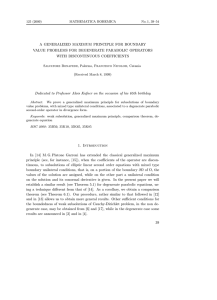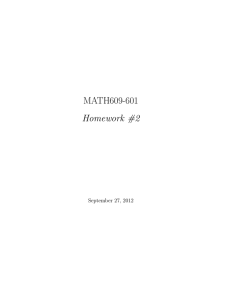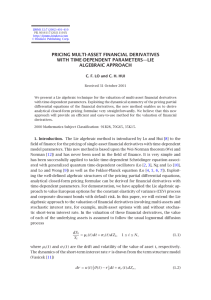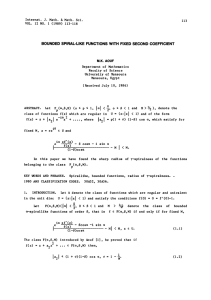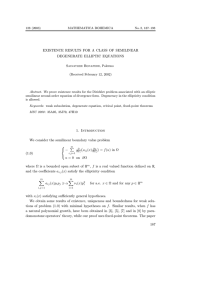THE INITIAL BOUNDARY VALUE PROBLEM FOR THE HIGH by Lech Zar¦ba
advertisement
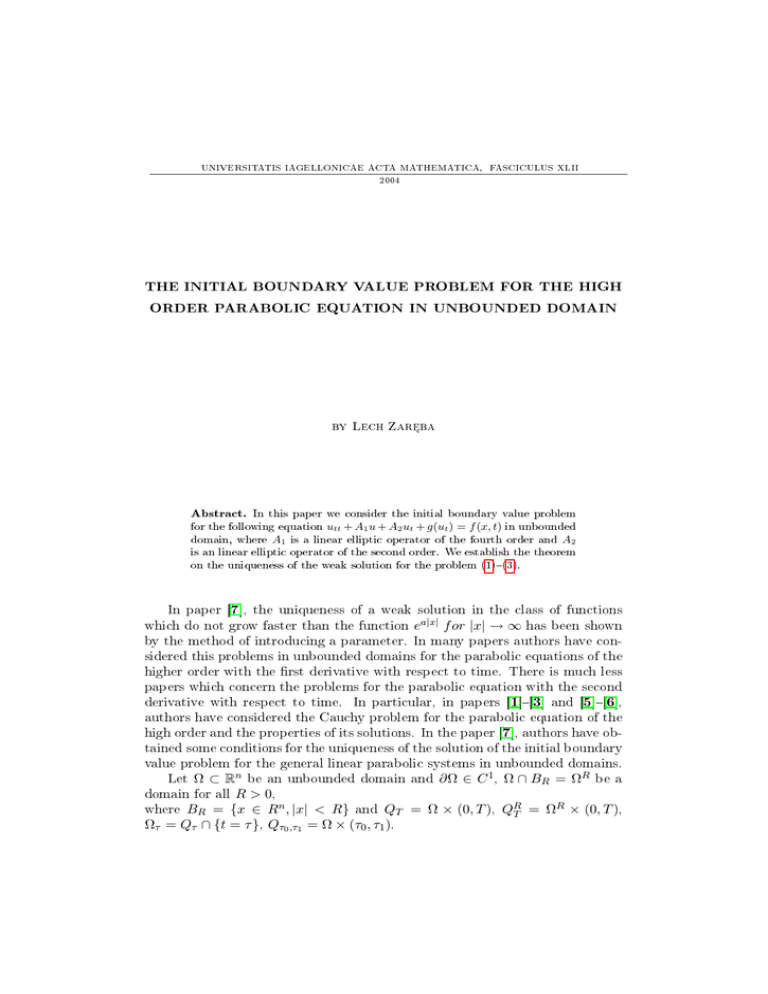
UNIVERSITATIS IAGELLONICAE ACTA MATHEMATICA,
FASCICULUS XLII
2004
THE INITIAL BOUNDARY VALUE PROBLEM FOR THE HIGH
ORDER PARABOLIC EQUATION IN UNBOUNDED DOMAIN
by Lech Zar¦ba
In this paper we consider the initial boundary value problem
for the following equation utt + A1 u + A2 ut + g(ut ) = f (x, t) in unbounded
domain, where A1 is a linear elliptic operator of the fourth order and A2
is an linear elliptic operator of the second order. We establish the theorem
on the uniqueness of the weak solution for the problem (1)(3).
Abstract.
In paper [7], the uniqueness of a weak solution in the class of functions
which do not grow faster than the function ea|x| f or |x| → ∞ has been shown
by the method of introducing a parameter. In many papers authors have considered this problems in unbounded domains for the parabolic equations of the
higher order with the rst derivative with respect to time. There is much less
papers which concern the problems for the parabolic equation with the second
derivative with respect to time. In particular, in papers [1][3] and [5][6],
authors have considered the Cauchy problem for the parabolic equation of the
high order and the properties of its solutions. In the paper [7], authors have obtained some conditions for the uniqueness of the solution of the initial boundary
value problem for the general linear parabolic systems in unbounded domains.
Let Ω ⊂ Rn be an unbounded domain and ∂Ω ∈ C 1 , Ω ∩ BR = ΩR be a
domain for all R > 0,
R
where BR = {x ∈ Rn , |x| < R} and QT = Ω × (0, T ), QR
T = Ω × (0, T ),
Ωτ = Qτ ∩ {t = τ }, Qτ0 ,τ1 = Ω × (τ0 , τ1 ).
96
We shall consider the equation of the form
n
X
utt (x, t) +
(akl
ij (x)uxi xj (x, t))xk xl −
i,j,k,l=1
(1)
−
n
X
(aij (x)uxi (x, t))xj −
i,j=1
n
X
(bij (x, t)utxi (x, t))xj +
i,j=1
+ a(x)u(x) + g(x, t, ut ) = f (x, t)
in the domain QT .
For this equation, we put the following boundary and initial conditions
(2)
u|ST = 0,
(3)
∂u
|S = 0,
∂ν T
u|t=0 = u0 (x), ut |t=0 = u1 (x),
where ST = ∂Ω × (0, T ) and ν is a normal vector for ST . Let us start with
some notation.
0,k
(Ω) = {u ∈ H k (ΩR ) : u|∂Ω∩BR = 0,
Hloc
∂ k−1 u
|∂Ω∩BR = 0, ∀R > 0}, k = 1, 2,
∂ν k−1
L2loc (Ω) = {u ∈ L2 (ΩR ), ∀R > 0}.
For the equation (1), we adapt the following system of assumptions:
ij
∞
(A1 ) akl
akl
ij ∈ L (Ω);
ij (x) = akl (x), for almost all x ∈ Ω;
n
n
P
P
2 for almost all x ∈ Ω
akl
ξij
ij (x)ξij ξkl ≥ a2
i,j=1
i,j,k,l=1
and for all ξ ∈ Rn(n−1)/2 , where a2 > 0 is a constant;
(A2 ) aij , aijxi ∈ L∞ (Ω), i, j = 1, ..., n; aij (x) = aji (x), for almost all x ∈ Ω;
n
P
aij (x)ξi ξj ≥ 0, for almost all x ∈ Ω and for all ξ ∈ Rn ;
ij=1
(A3 ) a ∈ L∞ (Ω),
a(x) ≥ a0 > 0 for almost all x ∈ Ω, where a0 is a constant;
(B) bij ∈ L∞ (Qτ ),
n
P
ij=1
bij (x, t)ξi ξj ≥ b0
n
P
i=1
ξi2 for almost all (x, t) ∈ Qτ
and for all ξ ∈ Rn , where b0 > 0 is a constant;
(G) The function (x, t) → g(x, t, ξ) is continuous for every ξ ∈ R
and the function ξ → g(x, t, ξ) is measurable for almost all (x, t) ∈ Qτ
and satises the following inequalities:
(g(x, t, ξ) − g(x, t, µ))(ξ − µ) ≥ g0 |ξ − µ|p for almost all (x, t) ∈ Qτ and
for all ξ, µ ∈ R, g0 = const ≥ 0;
|g(x, t, ξ)| ≤ g1 |ξ|p−1 , p ∈ (1, +∞) for almost all (x, t) ∈ Qτ and for
all ξ ∈ R.
97
Under this assumptions, we will obtain the uniqueness of a weak solution
of problem (1)(3).
We call a function u a weak solution of problem (1)(3) if
0,2
0,2
2
2
∗
u ∈ L (0, T ); Hloc (Ω) , utt ∈ L (0, T ); (Hloc (Ω)) ,
Definition.
0,1
(Ω) ∩ Lp (0, T ); Lploc (Ω) ,
ut ∈ L2 (0, T ); Hloc
and u satises the following integral equation
Z
Z n
X
ut (x, T )v(x, T )dx +
−ut vt +
akl
ij (x)uxi xj vxk xl +
Ω
i,j,k,l=1
QT
n
X
+
aij (x)uxi vxj + a(x)uv +
i,j=1
Z
f (x, t)vdxdt +
QT
∀v ∈ L2
bij (x, t)uxi t vxj
+ g(x, t, ut )v dxdt
i,j=1
Z
=
n
X
u1 (x)v(x, 0)dx
Ω
0,2
(0, T ); Hloc
(Ω) ∩ Lp (0, T ); Lploc (Ω) ,
vt ∈ L2 (0, T ); L2loc (Ω) ,
where supp v is bounded.
Let
− |x|2 ), for 0 ≤ |x| ≤ R,
0,
for
|x| > R.
Now, we dene the function Ψ by the formula
φR (x) =
(4)
1
2
R (R
Ψ(x) = [φR (x)]β , β > 1.
From (4) there follows
Ψxi = β(φR )β−1 φRxi , φRxi = −
2xi
, |φRxi | ≤ 2
R
for i = 1, 2, .., n. Hence
(5)
Ψ2xi
φ2β−2
≤ 4β 2 R β = Cφβ−2
R ,
Ψ
φ
R
where C = 4β 2 , for i = 1, 2, ..., n. From (4) and (5) we obtain
(6)
Ψ2xi
≤ C(2R)β−2
Ψ
98
and
(7)
|Ψxi xj | ≤ µ0 (φR )β−2 .
Theorem. If conditions (A1 )(A3 ), (B), (G) hold, then problem (1)(3)
has at most one weak solution in the class of the functions u such that
Z n
n
X
X
2
2
2
2
|u| +
|ut | +
|uxi xj | dxdt ≤ eaR ∀R > 0,
i=1
QR
i,j=1
where a > 0 is a constant.
Proof. To obtain a contradiction, suppose that there exist two solutions
u1 , u2 of problem (1)(3) such that u1 6= u2 .
Let τ0 , τ1 ∈ (0, τ ), τ0 < τ1 be xed and Θm be a continuous function on
[0, T ] such that
2
2
1
1
is a linear function in (τ0 + m , τ0 + m ) and (τ1 − m , τ1 − m ),
2
2
Θm (t) = 1,
if
τ0 + m
≤ t ≤ τ1 − m
,
1
1
.
0,
if
τ1 − m ≤ t or t ≤ τ0 + m
By {ρl } we denote the sequence which satises the following conditions
Z∞
ρl (t) = ρl (−t),
1 1
ρl (t)dt = 1, supp ρl ⊂ − , ,
l l
−∞
l ∈ N, l > 2m, [4]. Moreover, we put
γt
− γt
v = (Θm ut Ψe 2 ) ∗ ρl ∗ ρl Θm e− 2 , γ > 0,
where ∗ denotes the convolution with respect to t. Now, if we apply ∗ to
functions u1 , u2 , then for u = u1 − u2 we obtain
Z n
n
X
X
kl
−ut vt +
aij (x)uxi xj vxk xl +
aij (x)uxi vxj + a(x)uv
(8)
i,j,k,l=1
QT
+
n
X
i,j=1
bij (x, t)utxi vxj +
i,j=1
(g(x, t, u2t )
−
g(x, t, u1t ))v
dxdt = 0.
99
Let < ·, · > denote a scalar product in L2 (ΩR ). Taking into account the
assumption of the theorem and form of function v we obtain the following
equality
Z
I1 (m, l) := −
ut vt dxdt =
QT
Z
γ
=
2
− γt
2
ut Θm · (Θm ut Ψe
γt
) ∗ ρl ∗ ρl e− 2 dxdt
QT
Z
ut Θ0m
−
γt
− γt
2
) ∗ ρl ∗ ρl e− 2 dxdt
− γt
2
(Θm ut Ψe
QT
Z
−
ut Θm (Θm ut Ψe
t
QT
γ
=
2
γt
e− 2 dxdt
) ∗ ρl ∗ ρl
ZT
γt
γt
< (ut Θm e− 2 ) ∗ ρl , (ut Θm e− 2 ) ∗ ρl Ψ > dt
0
ZT
−
γt
γt
< (ut Θ0m e− 2 ) ∗ ρl , (ut Θm e− 2 ) ∗ ρl Ψ > dt
0
ZT
−
γt
γt
< (ut Θm e− 2 )t ∗ ρl , (ut Θm e− 2 ) ∗ ρl Ψ > dt →
Z0
Z
γ
→
u2t Θ2m e−γt Ψdxdt −
u2t Θm Θ0m e−γt Ψdxdt − 0 →
2
QT
QT
Z
γ 2
→
( Θm − Θm Θ0m )u2t e−γt Ψdxdt,
2
QT
when l → +∞. Next
Z
I2 (m, l) :=
n
X
QT i,j,k,l=1
1
2
3
akl
ij uxi xj vxk xl dxdt = I2 + I2 + I2 .
100
Here
I21 (m, l)
n
X
Z
:=
akl
ij uxi xj
− γt
2
· (Θm utxk xl Ψe
γt
) ∗ ρl ∗ ρl Θm e− 2 dxdt
QT i,j,k,l=1
=
ZT X
n
− γt
− γt
2
2
e
∗
ρ
,
Θ
u
∗ ρl Ψ > dt
< akl
Θ
u
e
m xk xl
m xi xj
l
ij
t
0 i,j,k,l=1
ZT X
n
γ
+
2
−
akl
ij
<
− γt
2
− γt
2
∗ ρl , Θm uxk xl e
Θm uxi xj e
∗ ρl Ψ > dt
0 i,j,k,l=1
ZT X
n
<
akl
ij
− γt
2
Θm uxi xj e
∗ ρl , l
γt
Θ0m uxk xl e− 2
∗ ρl Ψ > dt
0 i,j,k,l=1
=
ZT X
n
− γt
2
< akl
Θ
u
e
∗ ρl ,
m xi xj
ij
0 i,j,k,l=1
n
X
Z
→
QT i,j,k,l=1
γ
− γt
0
− γt
2
2
(Θm uxk xl e
) − (Θm uxk xl e
) ∗ ρl Ψ > dt
2
γ
0
−γt
akl
Ψdxdt,
ij uxi xj Θm ( Θm − Θm )uxk xl e
2
when l → +∞,
I22 (m, l) :=
Z
QT
n
X
akl
ij uxi xj Θm ·
i,j,k,l=1
n
X
Z
→
γt
− γt
2
Θm e
(utxk Ψxl + utxl Ψxk ) ∗ ρl ∗ ρl e− 2 dxdt
2
−γt
akl
dxdt,
ij uxi xj Θm (utxk Ψxl − utxl Ψxk )e
QT i,j,k,l=1
when l → +∞,
I23 (m, l)
Z
:=
→
n
X
QT i,j,k,l=1
Z X
n
QT i,j,k,l=1
akl
ij uxi xj Θm
− γt
2
· Θm e
ut Ψxl xl
2
−γt
akl
dxdt,
ij uxi xj ut Θm Ψxk xl e
γt
∗ ρl ∗ ρl e− 2 dxdt
101
when l → +∞. For the next integral we have
Z X
n
I3 (m, l) :=
aij uxi vxj dxdt
=
QT i,j=1
Z X
n
− γt
2
aij uxi Θm · Θm e
QT i,j=1
Z X
n
+
γt
utxj Ψ ∗ ρl ∗ ρl e− 2 dxdt
− γt
2
aij uxi Θm · Θm e
ut Ψxj
γt
∗ ρl ∗ ρl e− 2 dxdt
QT i,j=1
→
Z X
n
aij uxi utxj Θ2m Ψe−γt dxdt
QT i,j=1
+
Z X
n
aij uxi ut Θ2m Ψxj e−γt dxdt,
QT i,j=1
when l → +∞. For the next integral we obtain
Z X
n
I4 (m, l) :=
bij utxi vxj dxdt
=
QT i,j=1
Z X
n
γt
γt
bij utxi Θm · Θm e− 2 utxj Ψ ∗ ρl ∗ ρl e− 2 dxdt
QT i,j=1
Z X
n
+
→
− γt
2
bij utxi Θm · Θm e
QT i,j=1
Z X
n
ut Ψxj
bij utxi utxj Θ2m Ψe−γt dxdt +
QT i,j=1
γt
∗ ρl ∗ ρl e− 2 dxdt
Z X
n
bij uxi ut Θ2m Ψxj e−γt dxdt,
QT i,j=1
when l → +∞. And for next one there is
Z
I5 (m, l) :=
(g(x, t, u1t ) − g(x, t, u2t ))vdxdt
QT
Z
(g(x, t, u1t ) − g(x, t, u2t ))ut Θ2m Ψe−γt dxdt
→
QT
and
Z
Z
auvdxdt →
I6 (m, l) :=
QT
QT
auut Θ2m Ψe−γt dxdt.
102
If we pass with m to innity, we obtain
Z
Z
1
1
2 −γτ1
ut e
Ψdx −
u2t e−γτ0 Ψdx
2
2
Ωτ1
+
−
1
2
1
2
−γτ1
Ψdx
akl
ij uxi xj uxk xl e
Ωτ1 i,j,k,l=1
n
X
Z
−γτ0
Ψdx
akl
ij uxi xj uxk xl e
Ωτ0 i,j,k,l=1
Z
+
(9)
Ωτ0
n
X
Z
n
X
γ 2
γ
ut Ψ(x) +
2
2
i,j,k,l=1
Qτ0 ,τ1
+
+
+
n
X
akl
ij uxi xj uxk xl Ψ
akl
ij uxi xj (utxk Ψxl utxl Ψxk )
i,j,k,l=1
n
X
n
X
i,j=1
n
X
i,j=1
n
X
+
n
X
akl
ij uxi xj ut Ψxk xl
i,j,k,l=1
aij (x)uxi utxj Ψ +
aij (x)uxi ut Ψxj
bij (x, t)utxi utxj Ψ +
i,j=1
bij (x, t)utxi ut Ψxj
i,j=1
+ a(x)uut Ψ +
(g(x, t, u2t )
−
e−γt dxdt = 0,
g(x, t, u1t ))ut Ψ(x)
for almost all τ0 , τ1 ∈ (0, T ]. If we extend u, aij , bij , f, a, g by zero for t < 0,
then we can choose such τ0 in (9) that
Z
1
u2t e−γτ0 Ψdx = 0
2
Ωτ0
and
1
2
Z
n
X
−γτ0
akl
Ψdx = 0.
ij uxi xj uxk xl e
Ωτ0 i,j,k,l=1
From condition (A1 ) we infer
Z X
Z X
n
n
1
1
kl
−γτ1
I8 :=
aij uxi xj uxk xl e
Ψdx ≥ a2
|uxi xj |e−γτ1 Ψdx.
2
2
Ωτ1 i,j,k,l=1
Ωτ1 i,j=1
103
Next
I10
γ
:=
2
n
X
Z
n
X
I11 :=
n
X
|uxi xj |e−γτ1 Ψdx,
Qτ0 ,τ1 i,j=1
Qτ0 ,τ1 i,j,k,l=1
Z
Z
γ
≥ a2
2
−γτ1
Ψdx
akl
ij uxi xj uxk xl e
akl
ij (x)uxi xj
utxk Ψxl + utxl Ψxk e−γt dxdt
Qτ0 ,τ1 i,j,k,l=1
n
X
Z
=
−γt
dxdt +
(akl
ij )uxi xj utxk Ψxl e
Qτ i,j,k,l=1
Z X
n
≤
Ψ2xk
Ψ2xl
a02
|uxi xj |2
+
2δ3
Ψ
Ψ
δ3
2
2
+ (|utxk | + |utxl | )Ψ e−γt dxdt
2
4β 2 a02
+
δ3
τ
n
X
I12 :=
≤
Qτ i,j,k,l=1
δ2 a02 n2
2
Z X
n
|uxi xj |2 (φR )β−2 e−γt dxdt,
Qτ i,j=1
−γt
akl
Ψxk xl dxdt
ij uxi xj ut e
Qτ i,j,k,l=1
Z X
n
1
≤
2
−γt
dxdt
(akl
ij )uxi xj utxl Ψxk e
Qτ i,j,k,l=1
Qτ i,j,k,l=1
Z X
n
3
≤n δ3
|utxi |2 e−γt Ψ(x)dxdt
Q i=1
Z
n
X
Z
2
1
kl 2
2
2 (Ψxk xl )
δ2 (aij ) |uxi xj | Ψ(x) + |ut |
e−γt dxdt
δ2
Ψ
Z X
n
|uxi xj |2 e−γt Ψ(x)dxdt +
Qτ i,j=1
n4 µ0
2δ2
Z
|ut |2 (φR )β−2 e−γt dxdt.
Qτ
From assumption (A2 ) and the initial condition we obtain
I13 :=
Z X
n
aij uxi , utxj e−γt Ψ(x)dxdt
Qτ i,j=1
Z X
n
1
=
2
1
=
2
−γt
(aij uxi uxj e
Ωτ1 i,j=1
Z X
n
Ωτ1 i,j=1
γ
Ψ(x))t dx +
2
−γτ1
aij uxi uxj e
γ
Ψ(x)dx +
2
Z X
n
aij uxi uxj e−γt Ψ(x)dxdt
Qτ i,j=1
Z X
n
Qτ i,j=1
aij uxi uxj e−γt Ψ(x)dxdt.
104
Next, we have
Z X
n
I14 :=
aij uxi ut e−γt Ψxj dxdt
=
Qτ i,j=1
Zτ X
n
(aij u, ut e−γt Ψxj )xi dt −
0 i,j=1
Z X
n
−
Q
Z X
n
aijxi uut e−γt Ψxj dxdt
Qτ i,j=1
Z X
n
aij uutxi e−γt Ψxj dxdt −
i,j=1
Q
aij uut e−γt Ψxi xj dxdt
i,j=1
τ
Zτ X
n 2
(Ψ
a
1
x
ijxi
j)
2
2
≤
δ4 |u| Ψ +
e−γt dxdt
|ut |
2
δ4
Ψ
Qτ i,j=1
Z X
n (Ψxj )2 −γt
1
1
+
δ5 |utxi |2 Ψ + (aij )2 |u|2
e dxdt
2
δ5
Ψ
Qτ i,j=1
Z X
n 1
2
2
2
2 −γt
+
(aij ) |ut | |Ψxi xj | + |u| |Ψxi xj | e dxdt ≤
2
i,j=1
Qτ
Z
Z
β 2 a11 n2
1 2
2
β−2 −γt
≤
|ut | (φR )
e dxdt + n δ4 |u|2 Ψe−γt dxdt
δ4
2
Qτ
Qτ
Z
Z X
n
2
2
0
1
β a1 n
+
|utxi |2 Ψe−γt dxdt
|u|2 (φR )β−2 e−γt dxdt + nδ5
δ5
2
Qτ
Qτ i=1
Z
2µ Z
a01 n2 µ0
n
0
+
|ut |2 (φR )β−2 e−γt dxdt +
|u|2 (φR )β−2 e−γt dxdt.
2
2
Qτ
Qτ
From (B), there follows
Z X
Z X
n
n
−γt
I15 =
bij utxi utxj e Ψ(x)dxdt ≥ b0
|utxi |2 e−γt Ψ(x)dx,
I16 =
≤
≤
Qτ i,j=1
Z X
n
Qτ i=1
bij utxi ut e−γt Ψxj dxdt
Qτ i,j=1
Z X
n 1
2
δ0 (bij )2 |utxi |2 Ψ +
Qτ i,j=1
Z n
δ 0 b0 n X
2
Qτ i=1
2 −γt
|utxi | e
(Ψxj )2 −γt
1
|ut |2
e dxdt
δ0
Ψ
nβ 2 2
Ψ(x)dxdt +
δ0
Z
Qτ
|ut |2 (φR )β−2 e−γt dxdt.
105
Next, from (A3 ) and the initial condition, we infer
Z
I17 = a(x, t)uut e−γt Ψdxdt
Qτ
=
Z
1
2
(a|u|2 Ψe−γt )t dx +
γ
2
Ωτ1
1
≥ a0
2
Z
a(x, t)|u|2 Ψe−γt dxdt
Qτ
Z
γ
|u|2 Ψe−γτ1 dx + a0
2
Ω τ1
Z
|u|2 Ψe−γt dxdt.
Qτ
Moreover, by condition (G), we obtain
Z
−γt
I18 = (g(x, t, u2t ) − g(x, t, u1t ))uR
dxdt ≥ 0.
t Ψe
Qτ
From the estimates of the integrals I8 − I18 and (9), we obtain
Z
Z X
n
1
a2
2
−γτ1
ut Ψe
dx +
|uxi xj |2 Ψe−γτ1 dx
2
2
Ωτ1
Ωτ1 ij=1
Z
Z
γ
a0
2
−γτ1
|u| Ψe
dx +
|ut |2 Ψe−γt dxdt
+
2
2
Ω τ1
+
(10)
Qτ0 ,τ1
γa2
−
2
δ2 a02 n2
Z
n
X
Qτ
i,j=1
2
,τ
|uxi xj |2 Ψe−γt dxdt
0 1
Z X
n
0δ n
δ5 n
b
0
3
+ b0 − n δ 3 −
−
|utxi |2 Ψe−γt dxdt
2
2
Qτ0 ,τ1 i=1
Z
γa0 δ4 n2
−
|u|2 Ψe−γt dxdt
+
2
2
Qτ0 ,τ1
Z
4
n µ0 2β 2 n 2na11 β 2 n2 a01 µ0
≤
+
+
+
|ut |2 (φR )β−2 e−γt dxdt
2δ2
δ0
δ4
2
Qτ0 ,τ1
Z
2
0
2
n µ0 2a1 nβ
+
+
|u|2 (φR )β−2 e−γt dxdt
2
δ5
Qτ0 ,τ1
+
4a02 β 2
δ3
Z
n
X
Qτ0 ,τ1 ij=1
|uxi xj |2 (φR )β−2 e−γt dxdt.
106
Let R1 be xed and R1 < R.
Now, we choose γ = γ0 + γ1 , δ2 =
2
,
a02 n2
δ4 =
2
,
n2
γ1 = max{ a20 , a22 },
b0
2b0
δ0 = 3b2b00n , δ3 = 3n
3 , δ5 = 3n .
From (10), we obtain the following inequality
Z X
n |ut |2 + |uxi xj |2 + |u|2 Ψe−γ0 t dxdt ≤
γ0
R
Qτ 1
(11)
i,j=1
≤ KR
β−2
Z X
n 2
2
2 −γ0 t
dxdt.
|ut | + |uxi xj | + |u| e
QR
τ
i,j=1
Then, from (11), we conclude:
Z
Z
−γ0 t
β−2
(12)
γ0
we
Ψdxdt ≤ KR
we−γ0 t dxdt,
R
QR
τ
Qτ 1
n
P
2
2
2
where w =
|ut | + |uxi xj | + |u| .
ij=1
In ΩR1 ,
β
1
Ψ(x) = [φR (x)] =
(R − |x|)(R + |x|) ≥ (R − R1 )β .
R
(13)
β
Using (13) we obtain, from (12),
−γ0 τ
γ0 e
Z
β
wdxdt ≤ KR
(R − R1 )
R
Qτ 1
or
Z
(14)
wdxdt ≤
1
γ0
R
R − R1
β
eγ0 τ
R2
R
R→∞ R−R1
wdxdt
Z
wdxdt.
QR
τ
R
Since lim
Z
QR
τ
Qτ 1
(15)
β−2
= 1, we get, from (14),
Z
Z
K 1 γ0 τ
wdxdt ≤
e
wdxdt.
γ0 R2
R
Qτ 1
QR
τ
Let R = R2 . Then
(16)
Z
wdxdt ≤
R
Qτ 1
1
K
eγ0 τ
γ0 (R2 − R1 )2
Z
wdxdt.
R
Qτ 2
107
1
Moreover, let ρk = R2 −R
, k ∈ N , R1 (s) = R1 + sρk , R2 (s) = R1 (s) + ρk ,s =
k
0, 1, ..., k − 1. Then inequality (16) for R1 (s), R2 (s) and ρk will take the form
Z
Z
K 1 γ0 τ
(17)
e
wdxdt.
wdxdt ≤
γ0 ρ2k
R (s)
R (s)
Qτ 2
Qτ 1
From the form of R1 (s), R2 (s) , ρk and (17), we infer
Z
Z
K k γ0 τ
e
wdxdt.
(18)
wdxdt ≤
γ0 ρ2k
R
R
Qτ 2
Qτ 1
Choosing K and γ0 such that
K
γ0 ρ2k
k
< e−1 , putting the constants κ, λ, a, b0
such that R1 = 2m , R2 = 2m+1 , m ∈ N , κ = λ2m+1 , λ = 2 + [a], γ =
b0 λ2 2m+1 , b0 = 8K · e, and assuming that
Z
2
wdxdt ≤ eaR2
R
Qτ 2
we obtain, from (15),
Z
Z
2
(−κ+γ0 τ0 )
wdxdt ≤ e(−κ+γ0 τ0 +aR2 ) .
wdxdt ≤ e
R
R
Since
Qτ 2
Qτ 1
−κ + γ0 τ0 + aR22 = (−2 + a − [a] + b0 λ2 τ0 )2m+1 ≤ (−1 + b0 λ2 τ0 )2m+1 ,
it follows that for τ0 = min{T, 2b10 λ2 }
Z
m+1
wdxdt ≤ e−2
.
R
Qτ01
Hence for m → +∞, w(x, t) = 0 almost everywhere in Qτ0 . If τ0 < T , then we
can by analogy prove that w(x, t) = 0 almost everywhere in Qτ0 ,2τ0 etc.
Hence u(x, t) = u1 (x, t) − u2 (x, t) = 0.
References
1. Denisov V.N., Some properties of the solutions at (t → +∞) of the iterated heat equation,
Dierentsial'nye Uravneniya, 28, No. 1 (1992), 5969.
2. Denisov V.N., Stabilization of the solution of the Cauchy problem for the iterated heat
equation, Dierentsial'nye Uravneniya, 27, No. 1 (1991), 2942.
3. Itano M., Some remarks on the Cauchy problem for p-parabolic equations, Hiroshima Math.
J., 39 (1974), 211228.
108
4. Lions J.L., Quelques méthodes de résolution des probl ems aux limites non linéaires, Paris,
1969.
5. Maªecki R., Zieli«ska E., Contourintegral method applied for solving a certain mixed
problem for a parabolic equation of order four, Demon. Math., XV, No. 3 (1982).
6. Mikami M., The Cauchy problem for degenerate parabolic equations and Newton polygon,
Funkc. Ekvac., 39 (1996), 449468.
7. Oleinik O.A., Radkievich E.V., The method of introducing a parameter for the investigation
of evolution equations, Uspekhi Mat. Nauk., 203, No. 5 (1978), 776 (in Russian).
Received
March 1, 2004
University of Rzeszów
Institute of Mathematics
Rejtana 16A
35-959 Rzeszów, Poland
e-mail : Lzareba@univ.rzeszow.pl
